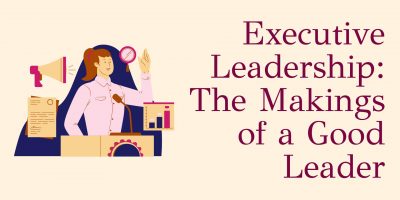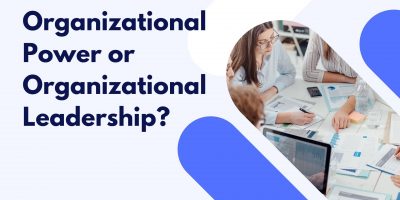
Executive Leadership: The Makings of a Good Leader
As the work landscape is changing, how can executive leadership help businesses adapt, excel, and drive organizational growth?

Integrity, as defined by C.S. Lewis, is doing the right thing, even when no one is watching. These profound words resonate deeply in today’s complex business landscape, where success and profitability often take precedence over integrity in the workplace.
Increasing societal pressures and rising transparency have left organizations grappling with the delicate balance between achieving their goals and upholding unwavering integrity.
From introducing the new role of Chief Integrity Officer (CIO) to updating their code of ethics – it’s clear that companies recognize the importance of integrity.
But are standalone ethical codes and integrity frameworks disconnected from corporate realities? Is upholding principles a liability or an asset that drives sustainable success? Can leaders truly build resilient and trustworthy businesses by integrating ethical considerations into the fabric of their organization?
To answer these questions, we examine the intricate interplay of integrity in the workplace and the practical realities of the modern workplace.
To truly understand integrity, it is essential to distinguish what integrity is not. It is not merely a superficial act of doing the right thing for appearance’s sake or to meet public scrutiny.
What is integrity in the workplace, then?
True integrity is consistently upholding high ethical standards because it is the morally correct course of action rather than seeking personal gain.
Having a strong sense of integrity in the workplace means that:
To foster integrity within an organization, it is crucial to develop a comprehensive understanding of the term and agree on a definition that aligns with the organization’s values and goals.
However, defining integrity in a business context is not an easy task.
Integrity is widely recognized as a fundamental core value, with fifty-five percent of Fortune 100 organizations highlighting its importance. While companies often include it as a pillar of their mission statements, it can be challenging to pinpoint its precise meaning in the day-to-day lives of employees.
In certain industries, established codes provide some insight into what integrity might look like in practical business scenarios.
For example, the financial sector’s FINRA Rule 2010 mandates that workers “observe high standards of commercial honor.” Similarly, the UK General Medical Council expects doctors to “always be honest about their experience, qualifications, and current role.”
From these examples, we can deduce that integrity revolves around consistently making ethical and morally sound choices whenever possible.
In the workplace context, integrity extends beyond compliance or ticking boxes. It transforms the fundamental question from “Is this allowed?” to “Is this right?” when it drives a business. Essentially, workplace integrity signifies a commitment to doing the right thing, especially in the face of adversity.
So, what does a workplace with integrity look like?
To gauge the presence of integrity within an organization’s culture, specific characteristics serve as telltale signs:
By embodying these characteristics, a workplace cultivates an atmosphere of integrity, fostering trust, ethical conduct, and positive work culture.
Amid geopolitical crises and economic uncertainties, it’s easy for organizations to focus all their resources solely on those challenges. However, there’s another crucial matter that organizations are addressing: ESG compliance.
While the global spotlight has been on the environmental and social aspects of ESG, leaders and organizations are finally putting the “G” of ESG on the agenda – governance.
Business leaders are increasingly acknowledging the tremendous value of fostering integrity structures. A recent survey by the OECD revealed that a remarkable 60% of companies viewed their investments in enhancing business integrity as highly valuable rather than merely perceiving it as an expense.
But why is integrity so important in the workplace? Is there a tangible connection between good behavior and business success?
Running an organization with integrity is not only the morally right thing to do, but it also brings about commercial benefits. Here are some reasons why integrity in the workplace matters:
Research has shown a clear link between integrity and business success. According to the Ethisphere Institute, organizations recognized as the World’s Most Ethical Companies outperformed the US large-cap sector by 14.4% over a five-year period.
Companies that prioritize integrity and transparency enjoy the advantage of a lower risk profile. Numerous studies have found that corporate transparency is associated with easier access to capital and lower costs, making it financially beneficial for businesses. This means that acting with integrity can lead to cheaper access to funding and reduced financial risks.
Companies with a robust commitment to integrity have been found to generate better returns for shareholders. Estimates suggest that these companies can achieve 10-year shareholder returns that are 7% higher than those with low integrity. By upholding ethical standards, businesses can create value for their shareholders and attract long-term investors.
A workplace culture rooted in integrity can significantly influence employee behavior. Research from the Corporate Executive Board indicates that employees in organizations with a strong culture of integrity are 90% less likely to observe misconduct in the workplace. Moreover, they are more inclined to report any misconduct they witness, fostering an environment of accountability and trust.
Companies demonstrating a genuine commitment to integrity are likely to face less severe consequences in the event of corruption. Many countries, including the United States, have enacted legislation that allows for reduced penalties or suspensions for firms with robust internal control systems in place. This means that businesses that prioritize integrity can mitigate potential legal and reputational risks more effectively

On the other hand, unethical behavior within a company can have far-reaching consequences, causing a ripple effect. In a company that lacks integrity, the costs of unethical behavior manifest themselves in various forms:
In today’s hyper-connected digital age, where news spreads rapidly through various media channels, the fallout from negative events can be devastating.
Therefore, maintaining integrity isn’t just a moral imperative but a strategic business move. It’s the foundation upon which trust is built, and trust is the currency of sustainable success.
Maintaining unwavering integrity may seem idealistic on paper, but it often clashes with competing priorities like performance and profitability in the complex business realm. Studies have revealed a disheartening reality: personal ethics can be the first standard to slip in moments of crisis.
Recent research conducted by EY sheds light on organizations’ struggles in upholding their standards amidst rapid change and challenging market conditions. A staggering 59% of respondents acknowledged the difficulty of maintaining integrity, with the figure rising to 63% for those operating in emerging markets.
These numbers paint a sobering picture and prompt crucial questions about the state of integrity in today’s corporate world.
Moreover, research indicates that as pressure mounts, the likelihood of employees observing misconduct within their organization also increases. This correlation is particularly pronounced in midsized organizations, where the risks are amplified.
Adding to this alarming reality is the fact that 46% of respondents believe that certain managers within their organizations would willingly sacrifice their integrity in pursuit of immediate profits. This distressing figure jumps to an even more concerning 51% when referring to senior managers who should serve as beacons of ethical leadership.
These findings are a stark reminder that upholding integrity in the face of competing priorities is an ongoing struggle.
One significant avenue for effectively addressing ethical challenges lies in implementing ethics and compliance training. A KPMG survey revealed that 87% of respondents from organizations with comprehensive compliance programs reported increased motivation among individuals to “do the right thing.”
Certain organizations have taken a bolder step by appointing a chief integrity officer to occupy a pivotal role in the C-suite. Compliance leaders, in particular, are entrusted with broader integrity responsibilities, including overseeing government relations and environmental, social, and governance (ESG) matters.
While appointing a chief integrity officer in the C-suite is a step in the right direction, that alone is not enough to address the multifaceted ethical challenges facing companies today.
Overcoming existing hurdles, such as inconsistent terminology, framing, and reporting recommendations, as well as the over-emphasis on environmental aspects in ESG relative to other material risks and opportunities, is essential.
Above all, integrity should not be confined to a singular role or department. It must permeate every level and function of an organization.
Despite approximately 60% of board members affirming that their organization has frequently communicated the importance of behaving with integrity over the past 18 months, only 30% of employees can recall such messages. Such disparity highlights the inherent challenge of effectively transmitting and embedding ethical values throughout an organization.
To bridge this communication gap, it is imperative to rethink how information is conveyed. Merely sending emails or issuing one-way communications about integrity is insufficient. Instead, organizations should strive for more interactive and engaging approaches that foster a stronger connection between employees and important ethical information.
For integrity and ethics to take root, leaders must go beyond mere words and actively explain, model, and act upon the organization’s values and code of conduct.
However, studies reveal a troubling trend: the higher an employee’s seniority, the greater the likelihood of engaging in unethical behavior. Senior employees often resort to justifying misconduct, such as ignoring wrongdoing within their teams, deceiving external parties like auditors or regulators, or succumbing to bribery to advance their own careers or financial gain.
Creating lasting change in organizational culture is a complex endeavor that far surpasses the scope of rules and regulations. It requires a concerted, long-term effort to transform the fundamental fabric of the organization rather than relying on
Integrity is not just a concept; it manifests through tangible actions that uphold ethical standards and foster trust in the workplace.
Here are some examples of integrity in the workplace and how they can be demonstrated across various aspects of business:
These examples illustrate that integrity permeates various aspects of the workplace, from advertising and supply chains to data privacy and employee treatment. Organizations can foster a culture of trust, accountability, and ethical conduct by consistently demonstrating integrity through actions.
So, where do you begin when aiming to cultivate a culture of integrity in the workplace?
Here are some strategies that can help in fostering workplace integrity:
Creating and maintaining a culture of integrity requires a strategic approach encompassing various aspects of an organization.

In an era where success often overshadows integrity, organizations must recognize the importance of upholding ethical standards in the workplace. By embracing integrity in the workplace as a core value and integrating it into all aspects of their operations, businesses can foster a culture of trust, mitigate risks, and ultimately achieve sustainable success in the long run.
Senior Content Writer at Shortlister
Browse our curated list of vendors to find the best solution for your needs.
Subscribe to our newsletter for the latest trends, expert tips, and workplace insights!

As the work landscape is changing, how can executive leadership help businesses adapt, excel, and drive organizational growth?

From fostering inclusive environments to advocating for equal opportunities – elevate your organization’s commitment to gender equality with actionable advice.

How are Millennials transforming the workforce and companies’ cultures, and what does that change mean for the future of work? What makes this generation good leaders?

What’s better, organizational power or organizational leadership? And can we have one without the other?
Used by most of the top employee benefits consultants in the US, Shortlister is where you can find, research and select HR and benefits vendors for your clients.
Shortlister helps you reach your ideal prospects. Claim your free account to control your message and receive employer, consultant and health plan leads.